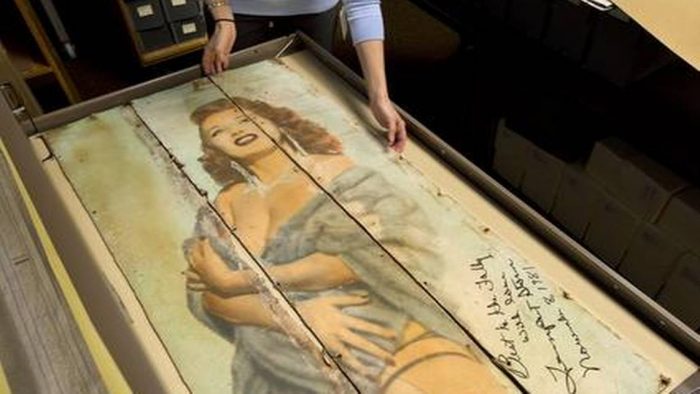Written by Gabrielle S. Bates
Edited by Sereen Suleiman and Lauren Kime
Vintage fans, sparkling rhinestone accents, sequins, feathers, fringe and art deco are all in the shadow of ancient Greece. You might be familiar with Dita Von Teese, the “Queen of Burlesque” who popularized the art to a fresh set of fans. Long before her, there was a history of women who mixed comedy, allure, music and dance to keep us captivated.
Kansas City Public Library houses the Missouri Valley Specials Collection, and they decided to take a risk when the nearby Folly Theater discovered the basement was filled with theater memorabilia. Most of the items are from 1940 – 2000; librarians culled the collection and took away 300 boxes worth of history. The basement discoveries include 80 player piano rolls, publicity shots, and show posters. Some of these items are from a time when the Folly was a Shakespearean playhouse, spanning over 120 years.

Source: URL
If you think the art of showgirls is a small niche, you would be incorrect. Washington University in St. Louis also houses a Burlesque collection. Harry Wald owned and managed the Grand Theater, and his passion for entertainment cultivated The Harry Wald Collection. This film collection showcases 250 35mm burlesque films dating from the 1930s to the 1960s. Additionally, the collection includes a 1954 copy of the film, “Dance Hall Racket”, written and directed by the comedian Lenny Bruce. As live burlesque shows were dying out, Harry was inspired to put together a team to film some of the burlesque acts. Being able to repeatedly show these films at the theater increased their profits and helped keep the art of burlesque alive.
People are captivated by burlesque in different ways. For Laurie Kurutz, Professor of Costume Technology at The Oregon Center for the Arts, the intrigue into the world of burlesque began because of a former student. Laurie began researching the style and construction of Burlesque costumes. This led her to begin the project, “Voices of Oregon Burlesque”, consisting of interviews of diverse individuals. Kurutz sees art as an expression of joy, a way for storytelling, and a voice for marginalized groups to use their bodies to be part of social change. This is an ongoing project in conjunction with the Oral History Program, which is part of the Special Collections and Archives Research Center at Oregon State University. Interviews are estimated to be posted later this year and will continue into 2022.
Source: URL
One of the digital collections from the University of Nevada Las Vegas highlights showgirls, specifically what is referred to as the Frenchified version. With one foot in burlesque and one in Paris, the focus of these shows is not the human body but rather how the costumes move on the body. These show costumes are often flashy and exaggerated as they emphasize the female form. The designers remind us to view the costume as the object and not the woman.
In old downtown Vegas, now known as the Arts District, sits the Burlesque Hall of Fame Museum. This museum is a true labor of love, and it began as the personal collection of Jennie Lee, who helped organize a union for dancers in the 50s. After Jennie Lee’s death, her dear friend, Dixie Evans, kept the museum running as a nonprofit with the help of fundraisers. The museum’s mission is to preserve the art of burlesque, be it through numerous educational exhibits, keeping the memory alive of historical dancers, preserving show costumes & props and continuing to document current entertainers. They are more than happy to assist anyone serious about research and have a collection of over 4,000 pieces, including items from historical dancers like Gypsy Rose Lee and Sally Rand.

Source: URL
One of the performers revered in the Burlesque Hall of Fame Collection is Coby Yee. Coby is a Chinese nightclub and San Francisco legend. Yee was a showgirl, trained dancer, costume designer, dance instructor, club hostess and the face of the Forbidden City nightclub. She is also known for creating elaborately layered costumes. With each article she removed, the house lights would dim, growing darker and darker, obscuring her, allowing her to keep a sliver of modesty. She also profited from designing costumes and choreography for other performers. It was not uncommon to see her carrying her sewing machine. Many of her creations were never seen by the public.
A tribute to Coby Yee is hidden underneath the Clarion Performing Arts Center. Brimming with stories, well-loved costumes and ornate jewelry the Showgirl Magic Museum is a celebration of mid-20th century Chinese nightclub culture. The museum was started in March 2020 to showcase the history of Yee and other dancers from the Grant Avenue Follies. The original GAF lineup featured Coby Yee, Ivy Tam, Pat Chinn, and Isabel Louie. In 2003, they reconnected due to doctors’ orders to be more active. You can see some of their performances on YouTube. Always a trailblazer, Coby Yee believed dancing kept her young. Yee’s last performance was in February 2020 at the age of 93, six months before she died. May we all be so lucky!


